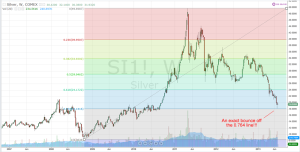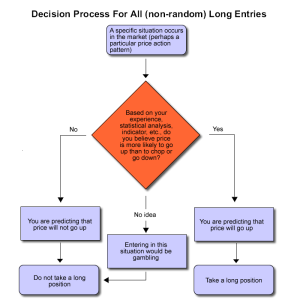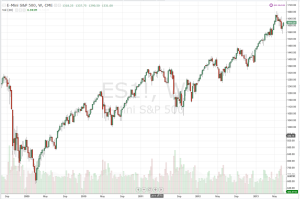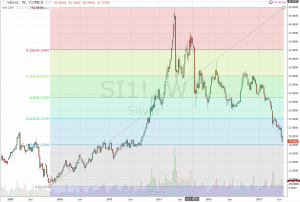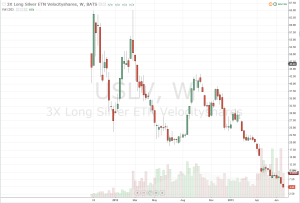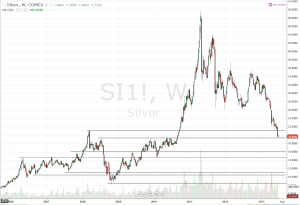Trading seems to be one of the few industries where the less information someone gives, the more people seem to think they know what they are talking about.
If you’ve spent any time on any of the major trading forums, you’ll see that often the people who are most respected as trading “gurus” or people who give the most knowledge actually say the least. I don’t mean their posts are short, although sometimes that is the case, but I mean the amount of actual, quantifiable, useful information they give is very small.
Trading “gurus” seem to realize this and know that they can string people along by giving them a little info and often phrasing it as a riddle or some other nonsense.
It makes no sense. If you asked your math teacher a specific question and their reply was “what do the numbers tell you to do?” do you think that math teacher would still have a job next year? Of course not. All their students would fail.
If your GPS gave you some overly complex gibberish instead of saying “turn right in 0.3 miles,” do you think people would continue to buy that model of GPS? Of course not. They would tell their friends “dude, this brand sucks, don’t buy it” and that company would go out of business.
If you bought a complex piece of technology and the instructions said “hook everything together so it works,” do you think people would be happy with that product? Of course not. They would take it back and buy another one that wasn’t such a pain.
But for some reason, people who are trying to learn how to trade are satisfied with non-specific instruction.
Perhaps they think it’s because they think real life is like a 70’s kung fu movie where the master speaks in riddles and the student, after lots of hard work, suddenly “gets it” and can defeat his enemy. After all, “kung fu” translates into “skill developed through hard work.” And technically you can have “kung fu” in anything if you’re good at it after having practiced it for a long time.
On that note, one of the other areas where students are content with vague answers is the traditional martial arts world. Hang out in a school long enough and you might see that the instructor never spars with his students (he’s “too deadly,” after all), the students never spar with each other or compete in tournaments (they’re told what they learn is “too deadly for the ring”), and the instructor might never quite be specific with anything because, you know, his students might find out that he can’t actually apply what he teaches. You’ll also see this at those schools where they claim to teach you to knock people out without even touching them (funny how it only works on their own gullible students but not on resisting opponents).
Not coincidentally, these students often lose street fights because they never actually trained against a resisting opponent but they have a huge amount of false confidence because they actually think they are super deadly.
The other area where this seems common is seminars where they teach you to invest in real estate. Although I’ve never been to one, I’ve been told that the instructors don’t actually practice what they preach (imagine that), and instead make their money through high priced seminars and courses. I’ve been told that the “instruction” given in these is not specific enough to actually help with anything and that they just try to upsell more expensive garbage. I’ve also been told that some of the methods taught aren’t even legal. Again, I don’t know anything about that, but it’s not surprising.
So back to these long threads by the trading “gurus.” Why are they so long? Because noobs think these people being all vague actually hold the answers. But you will notice that none of these “gurus” will ever:
– make real time calls
– post specifics about their method
– answer questions directly
– post verified or notarized account statements
Making real time calls would let everyone see if you could actually trade or not. Can’t do that!
Posting specifics about their method would let people actually test the method which would reveal if it was profitable or not. Can’t let that happen!
Answering questions directly might cause them to accidentally give away enough specifics so that people could test their method. Can’t have that!
Posting verified account statements would actually be a bit of a pain, but if someone is claiming to teach a profitable method, the onus of proof is on the person making the claim. This should be especially true if someone is charging for their instruction. Why would you pay money to learn from someone who hasn’t shown proof that they are a profitable trader? And to go back to an example from above, why would you pay for instruction from someone who claims to be able to teach you to knock someone out without touching them if they haven’t shown they can do it? Do you just take them at their word? The onus of proof is on the person making the claim. If someone could even demonstrate this skill against a resisting opponent one time they would have thousands of students from all over the world willing to pay to learn their methods. Similarly, if any of these trading “gurus” could prove that they were actually profitable traders, they would have more students than they knew what to do with. Of course, if they were actually profitable traders, they wouldn’t need to sell courses to make money.
Instead you will see a lot of:
– vague descriptions
– overly complex descriptions to specific questions. Instead of saying something like “enter when price does this,” they will take 3 paragraphs and talk about all sorts of things using buzzwords they made up but never defined and circular logic, thus making it impossible for anyone to actually get anything useful from their answer. However, it’s all set up so that on the surface it looks like you got a good, detailed answer.
– blaming the student. Did you lose money trying to trade my method? You must’ve done something wrong. Reread my posts and try again. All the answers are there, grasshopper.
As I have said before, the number one rule when trying to learn something is this.
Ask a specific question? Get a specific answer.
If you ask a specific question and do not get a specific answer, it means one of four things:
1) the person misunderstood your question. In this case, ask one more time. Perhaps rephrase the question. Misunderstandings do happen.
2) the person is BS’ing you (and therefore has no method to teach you, and therefore cannot give you a specific answer, and therefore you cannot learn from them)
3) the person doesn’t want to teach you (and therefore you cannot learn from them)
4) the person is unable to teach you, even if they themselves have shown demonstrable proof that they are successful at what they are doing (since they are unable to teach you, you cannot learn from them).
A special note about number 4: it is often the natural inclination of someone who wants to improve at something to seek instruction from those who are the best. Often the person who is the best at something had a natural ability at that thing, anyway, and may be unable to tell others how they do it. If something has always been easy for someone, they may not even logically understand the difficulties that other people may have with it. I have known a few people who were very skilled at certain things yet completely unable to explain how they did it. They “just did them.” The best teachers are often the ones who developed skill after a lot of struggle as they can relate to the difficulties others may have.
So of those 4 situations above, 3 of them mean you are unable to learn from the person, so move on.



